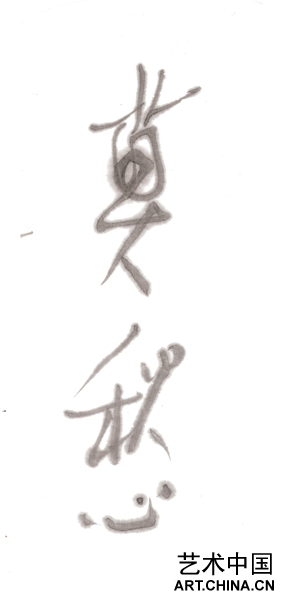|

2008年10月20日
莫愁——邱志傑近作
展覽時間:2008年10月25日至12月6日
開幕式:2008年10月25日,下午3-5點
北京前波畫廊很榮幸地宣佈邱志傑的展覽《莫愁》將於2008年10月25日開幕,這是繼2006年紐約前波畫廊《時間的形狀》展覽之後邱志傑在前波畫廊的第二次個展。本次展覽的現場裝置以及一系列最新創作的木刻、紙本水墨延續了藝術家進行中的對南京(尤其是南京長江大橋)的研究計劃。
近年來,邱志傑關注的項目都需要高密度的考察、取證,並製作跨媒介的作品。從他參加的初期的長征計劃開始,到他追尋印度著名探險家Nain Singh足跡的漫長的拉薩-加德滿都之行,以及目前他對南京這座城市的深入探索,邱志傑開始著手于更宏大的文化之旅,從中調查同今日生活緊密相關的中國歷史文化的諸多方面。迄今為止其最為宏大的是《南京長江大橋自殺現象干預計劃》——一個涉足文獻、調研與社會活動的項目(在此案例裏,他同一支自殺干預小組合作),以多種媒體創作藝術作品。《莫愁》亦是邱志傑總體藝術創作的一部分,雖然表達上較為含蓄。
邱志傑同南京的關係始於2005年,當時他策劃了《未來考古學——第二屆南京三年展》。2007年的半年裏,他開始關注南京長江大橋,尤其是這雄偉的符號與當地高發的自殺率之間的關係。其調研和文獻最終孕育了大範圍的藝術創作,包括在新加坡泰勒版畫學院創作的一批限量版的版畫和單件的紙本作品以及包括《莫愁》在內的現場裝置。
此次北京前波畫廊的裝置緣出一件石板畫,其基於莫愁湖的傳説——清代一名貧窮的姑娘賣身葬父的故事。婚姻的不幸使之投湖自盡,而今日作為的南京旅遊名勝的這座湖也因此得名。
邱志傑本次裝置的核心是一件碩大的、晶體形狀的抽象雕塑。雕塑本是一座太湖石,而其自然原生的形態盡被藝術家切割而去。切下的石塊被置於畫廊墻面。盲人可經由周圍的盲道摸索這些石塊從而感知這個展覽,另一邊有噴泉落於此雕塑,以期用流水使之蛻變回一塊太湖石。同時展出的還有一批木刻和紙本水墨,作為邱志傑作品裏神秘、縈繞不散的意象的進一步的變體。通過對長江大橋——這座崛起的中國的象徵以及如莫愁湖這樣典故的關注,邱志傑探索著時間、記憶、命運等主題,此乃其創作的核心所在,無論他的興趣在於何種媒介。
October 20, 2008
Mochou
Recent Works by Qiu Zhijie
October 25 through December 6, 2008
Opening reception: Saturday, October 25, 3-5pm
Chambers Fine Art Beijing is pleased to announce the opening on October 25, 2008 of Mochou by Qiu Zhijie, his second exhibition at the gallery following The Shape of Time: Light Calli-photography by Qiu Zhijie at Chambers Fine Art New York in 2006. The installation and a new series of woodcuts and ink drawings on paper are associated with the artist’s ongoing investigation of the history of Nanjing and in particular the Nanjing Yangtze River Bridge, inaugurated in 1968 and regarded as a great triumph of Chinese power and resourcefulness.
In recent years Qiu Zhijie has been focusing on projects that require extensive travel and documentation in association with the production of works of art in a variety of media. Beginning with his association with the first phase of the Long March Project, continuing with his epic journey from Lhasa to Khatmandu in the footsteps of Nain Singh and now with his deep involvement with the city of Nanjing, Qiu Zhijie has embarked on an ambitious cultural voyage, investigating aspects of Chinese history and culture as they impinge on life today. Most ambitious by far is A Suicidology of the Nanjing Yangtze River Bridge, the title for an ongoing project involving documentation, research and social activism (in this case, working with a suicide-prevention squad) in association with the production of works of art in many media. Mochou is affiliated with Qiu Zhijie’s gesamtkunstwerk though in an indirect way.
His association with Nanjing began in 2005 when he curated Archaeology of the Future, the second Nanjing Triennial. From the second half of 2007, he began to focus on the Nanjing Yangtze River Bridge and in particular the relationship between this potent symbol and the high rate of suicides that occur there. Research and documentation led to a wide range of artistic productions, including a group of editioned prints and unique works on paper made at Singapore Tyler Print Institute and independent installations such as Mochou.
Related to one of the lithographs, the installation at Chambers Fine Art Beijing is based on the legend of Mochou, a young girl who lived in the Qin Dynasty, who was so poor that she had to sell herself to pay for her father’s funeral. Deeply unhappy in her marriage, she committed suicide in the lake that now bears her name and is one of the most popular tourist destinations in Nanjing.
The central feature of Qiu Zhijie’s installation is a large, crystalline abstract sculpture, originally a scholar’s rock from which all the naturally formed projections have been sliced off. These are attached to the wall of the gallery. A path for the blind enables the visually impaired to touch the rocks and feel their way around the gallery while a stream of water trickles down the abstract sculpture, beginning the process that will eventually return it to its original form as a scholar’s rock. Accompanying the installation is a new series of woodcuts and ink drawings on paper, further variations on Qiu Zhijie’s haunting and mysterious imagery. By focusing on the bridge which is such a potent symbol of China’s emerging power and related themes from China’s past such as Mochou, Qiu Zhijie explores themes such as time, memory and destiny, issues that have always been central to his interests in whatever medium he worked.
|

